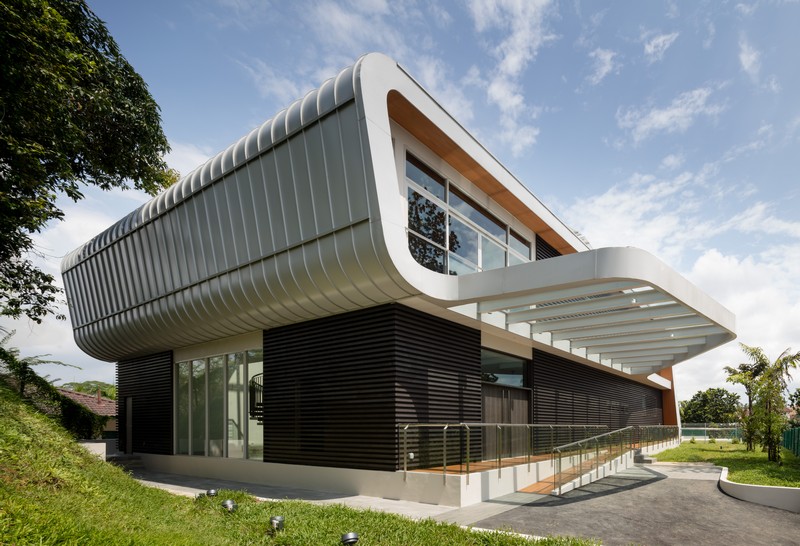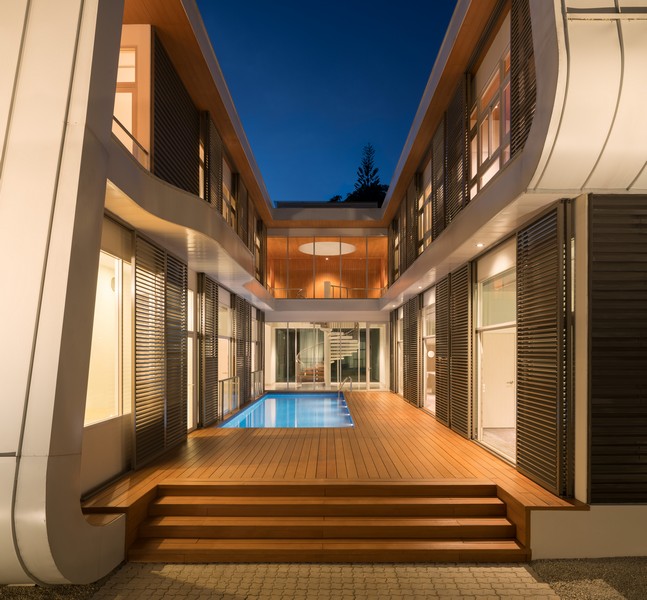Pioneering operational carbon-negative home generates more green power than it consumes, costs the same as similar properties in the area, and draws on many of the passive design techniques used in Singapore’s iconic Black and White colonial bungalows.
Pomeroy Studio,has announced the completion of their pioneering operational carbon-negative home: the B House, in Singapore. The home, which is highly water, energy and waste efficient, offsets the energy requirements of its occupants (i.e. operational carbon zero) through the use of solar energy, and provides surplus energy that could in the future be fed back into the grid. The B House employs many of the passive design techniques used in Singapore’s colonial Black and White bungalows; and when coupled with modern technology, results in one of the most sustainable detached modern homes in the region at the same price point as the neighbouring residential developments.
“The owner of the B House was keen to push the boundaries of sustainable design for a private commission of two family bungalows in Bukit Timah, Singapore” said Founding Principal Prof. Jason Pomeroy, continuing “the home sought to ensure that the occupants would never have energy bills again, and greatly reduced water bills. The challenge therefore was to create a zero carbon house at the same cost of a bungalow comparable in scale. What started as a carbon zero project would eventually become a pioneering operational carbon negative house in Singapore”
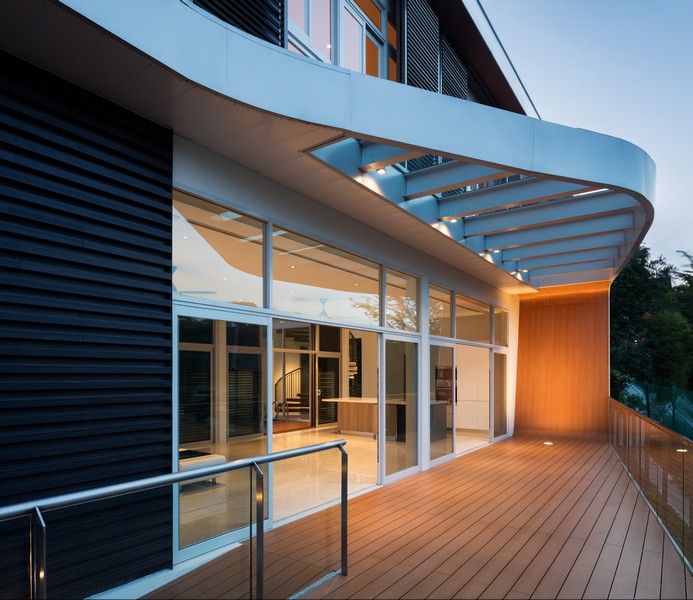
The B House drew on many of the lessons learnt from Asia’s first carbon-zero prototype home, the Sime Darby Idea House (2010) in Malaysia, which was also designed by Prof. Pomeroy, an expert in sustainable design and zerocarbon development. Whilst the Idea House reinterpreted the techniques embedded in the Malay Kampong House, B House provided an opportunity for Pomeroy Studio to study the traditional Black and White bungalow of Singapore. Such buildings featured generous roof overhangs, large Verandahs for outdoor living and entertaining, and variable shutters that could keep the sun out but allow the air to percolate in. Learning from its passive design techniques and space planning principles allowed for their subsequent reinterpretation for the 21st century tropical house.
Like the Black and White bungalows before it, the B House takes a ‘formmatching- climate’ approach that embraces the climatic conditions of Singapore in order to reduce energy and water use. The house is orientated and shaped to minimise heat from the East and West sun – reducing solar heat gain an maximising cross ventilation through the prevailing wind. Airflow is further facilitated through strategically placed window openings and high ceilings. North and South façades comprise of low, medium and high-level windows and shutters that act like a series of valves in a similar fashion to its historical predecessor. These can be opened and closed in multiple configurations to regulate airflow, prevent rain, and provide shade whilst filtering light during the hottest or wettest seasons. Daylight penetration is further optimised through shallow floor plates that permit all habitable rooms to receive 100% natural light.
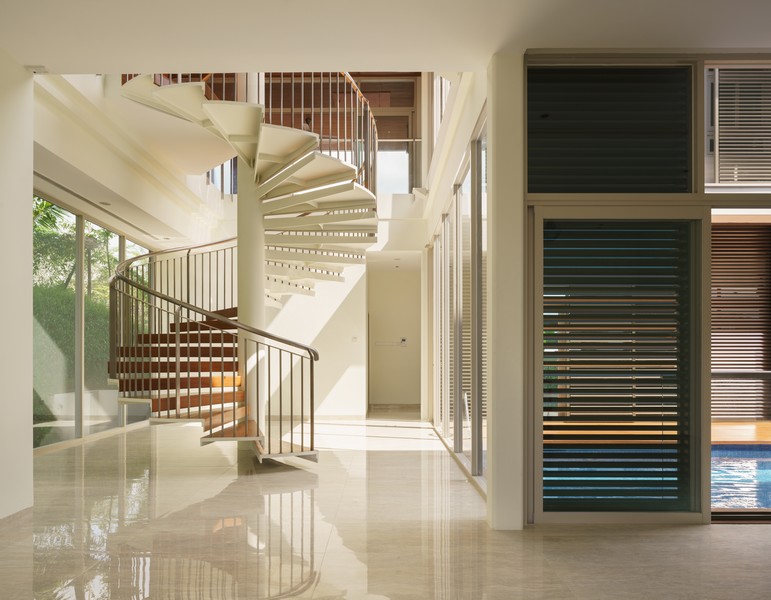
Colonial and Asian dwellings were marked by the presence of Courtyards and Verandahs, serving as places of social interaction while also cooling the buildings themselves, as the breeze entering into the home through such spaces would be cooled by the surrounding foliage. The B House features both. Verandahs line both wings of the house, channelling cooler air into the interiors, and the central Courtyard is strategically placed between the more public formal reception area and private areas. This ensures that natural light and ventilation percolate into the interior spaces, and also acts as an outdoor social space .
The passive design techniques drawn from the traditional Asian dwellings provided a low energy base from which Pomeroy Studio were able to incorporate the latest green technologies and practices, giving the house its carbon-negative credential. The design of the house is modular, allowing pre-fabricated modules to be manufactured off-site, improving quality and reducing wasteful off-cuts. This pre-fabricated ‘kit-of-parts’ also increased the speed and efficiency of construction by 50% as compared to a similar sized residential building. Furthermore, materials with low eco-toxicity and high recyclable content were used throughout, and water-harvesting equipment with a water saving system forecasted to save up to 465m3 of water per year. The household energy consumption for a typical family of five in a ‘normal’ home is estimated at 12,500 kWh per year, while a family of five in the passively designed B House is estimated to consume approximately 8,000 kWh per year. The 100m2 of polycrystalline photovoltaic solar panels on the roof are expected to generate 16,720 kWh per year, meaning that the B House effectively acts as power station that provides surplus energy that could be supplied back into the grid f or income generation.
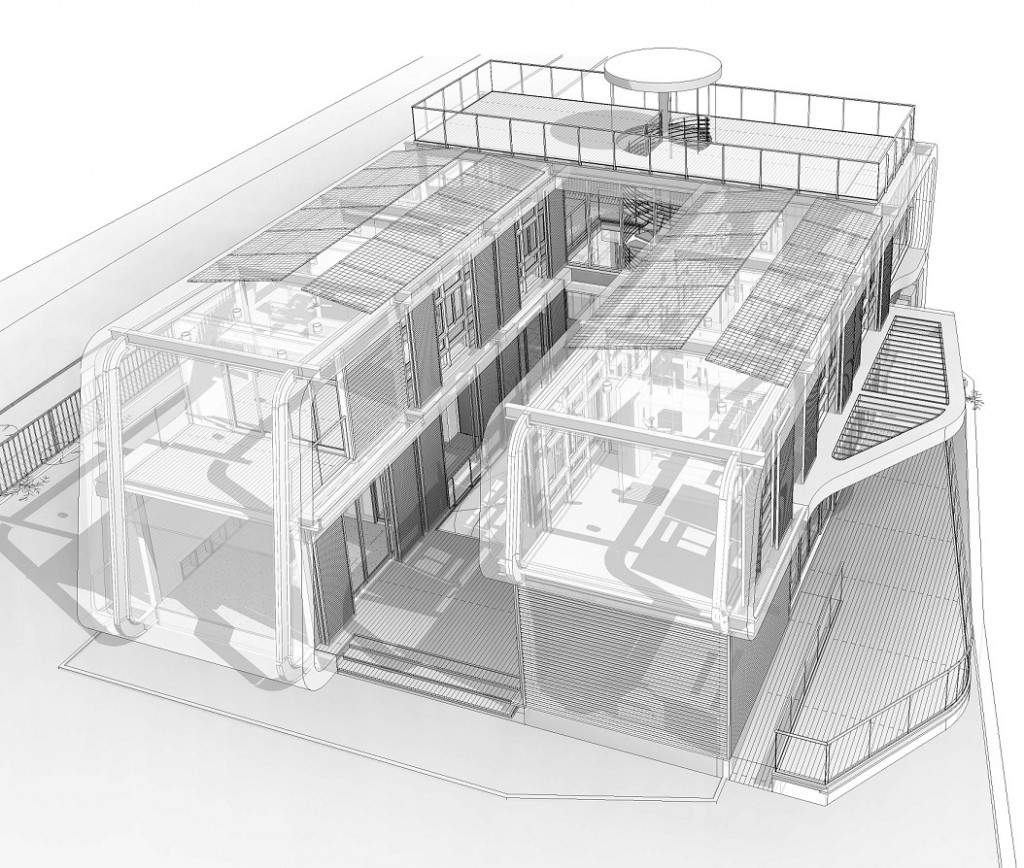 By looking to the past to shape the future, the B House highlights the importance culture and tradition plays in addressing many of the environmental challenges facing Singapore and Asia, “The future of sustainability is not just about technology, but, like the B House, draws on the essence of culture and tradition to create built environments that are carbon-free and truly reflect their inhabitants’ way of life” said Pomeroy, adding “We are delighted to have been given the opportunity to design this carbon negative home in Singapore. This project complements our Studio’s continued research into the field of zero-carbon development and its application to commercially orientated projects. We are proud to have been able to push the boundaries of sustainable design at the same price point as the ‘business as usual’, whilst retaining a commitment to the culture of place”.
By looking to the past to shape the future, the B House highlights the importance culture and tradition plays in addressing many of the environmental challenges facing Singapore and Asia, “The future of sustainability is not just about technology, but, like the B House, draws on the essence of culture and tradition to create built environments that are carbon-free and truly reflect their inhabitants’ way of life” said Pomeroy, adding “We are delighted to have been given the opportunity to design this carbon negative home in Singapore. This project complements our Studio’s continued research into the field of zero-carbon development and its application to commercially orientated projects. We are proud to have been able to push the boundaries of sustainable design at the same price point as the ‘business as usual’, whilst retaining a commitment to the culture of place”.
The B House has been awarded the Building Construction Authority’s (BCA) Green Mark Platinum Award, the highest award for environment-friendly buildings in Singapore.
Design Team
Prof. Jason Pomeroy (Principal and Director-in-Charge), Yoshi Shimada (Associate Principal), Deepshi Bhogal (Senior Sustainability Consultant), Mayank Kaushal (Senior Sustainability Consultant), Elizabeth Garcia (Architectural Designer).
About Pomeroy Studio
Pomeroy Studio is an award-winning international team of designers and thought leaders of sustainable built environments. The studio comprises of master planners, landscape architects, architects, interior and graphic designers, as well as sustainability consultants and academics. Quantitative and qualitative research complements an interdisciplinary design process that lies at the foundation of their creative design and decision-making. This has allowed the studio to generate people-centred places, from the micro-scale of dwellings to the macro-scale of cities, that pushes the envelope of design and research by balancing a ‘creative vigour with an academic rigour’. www.pomeroystudio.sg
For more information, please contact Chloe Li by phone +65 6592 6827 or email: [email protected]
Photographs © Robert Such and courtesy of Pomeroy Studio.













